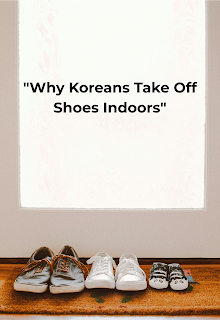Why Koreans Take Off Shoes Indoors | Cultural Reasons & American Reactions
 |
| Image source: Pexels |
Why Koreans Take Off Shoes Indoors (And Why Americans Find It Surprising)
In many Korean homes, it’s second nature to remove shoes before stepping inside. This simple act is more than just a habit — it’s a reflection of deeper cultural values centered on cleanliness, respect, and the boundary between the outside world and personal space.
Cleanliness Comes First
Koreans place a strong emphasis on keeping living spaces clean. The outside world is considered dirty, especially the soles of shoes that touch streets, public transport, and countless other surfaces. Removing shoes keeps those germs and dirt out of the home, which is especially important in a country where people often sit, eat, and even sleep close to the floor.Respecting the Home
Taking off shoes is also a way to show respect for the household and its inhabitants. This practice extends beyond private homes — it’s common in traditional restaurants, temples, and some schools. It communicates a sense of mindfulness and consideration for shared spaces.
Historical Roots
Historically, many Korean homes had ondol, an underfloor heating system. People sat and slept on the floor, making it essential to keep the floors as clean as possible. Though modern Koreans often use beds and chairs, the cultural habit remains strong.
Why It Surprises Americans
In many American households, keeping shoes on indoors is normal. This can be due to different housing designs, regional habits, or simply convenience. As a result, visitors to Korean homes might be surprised — or even a bit confused — when asked to remove their shoes.
The Shift in American Homes
Interestingly, more American families today are starting to adopt the "no shoes indoors" rule. Concernsabout hygiene, allergies, and indoor air quality are encouraging a cultural shift. Parents with young children, in particular, are choosing to keep floors clean and safe by following this practice.
Health Benefits
Removing shoes indoors doesn’t just keep the floors clean — it can also reduce exposure to allergens, dust, and harmful bacteria brought in from outside. Both Korean and American families are recognizing the health advantages of this simple habit.
I remember once, a friend visited my house and walked right in with their shoes. I didn’t say anything at the time, but inside I was like—oh no, my clean floors!!!
After that, I started keeping a little basket of slippers by the door. Now, anyone who visits can just slip them on. Some even say it feels cozy, like a little spa.
For me, it’s not just a habit—it’s part of feeling at home. I like knowing the floor is clean when I sit down or stretch, especially since I still do a lot of things on the floor, like folding laundry or sorting groceries.
Bridging Cultural Gaps
As Korean culture becomes more global through K-dramas, K-pop, and international travel, many Americans are becoming more familiar with this tradition. Some even adopt it themselves after understanding its benefits and cultural significance.
So next time you visit a Korean friend’s home, don’t be surprised when you’re asked to leave your shoes at the door. It’s not just about keeping the floor clean — it’s about honoring a meaningful tradition.
Do you keep your shoes on or off indoors? Let me know in the comments below!
Curious about other everyday Korean customs?
You might enjoy this post on [why bowing matters in Korean culture].





Comments
Post a Comment